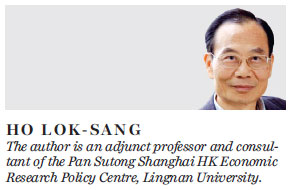Time to reshuffle our tunnel traffic
Updated: 2016-08-09 07:39
By Ho Lok-sang(HK Edition)
|
|||||||||
Ho Lok-sang argues that HK now has a great opportunity to rationalize the use of its three cross-harbor tunnels and offers advice on how to make them more efficient
The government's resumption of the ownership of the Eastern Harbour Crossing (EHC) offers a golden opportunity to rationalize the use of our cross-harbor tunnels.
Presently we have three cross-harbor tunnels. All of them were constructed following the Build-operate-transfer model. They were all constructed with private funds and operated by the private tunnel builder for a term which would offer the builder an income stream that would cover the building costs as well as bring profits. When this term expired the government would take over the ownership and operation. This model saves the government the cost of the initial investment, but the tunnel builder will need to recover the investment cost and make a reasonable return on the investment. This means that the tunnel is usually allowed to charge a toll that may be higher than what is socially optimal.

Readers may be puzzled by "what is socially optimal". Certainly, to most people a lower toll is always preferable. According to this logic tunnels should be free, if that is at all possible. After all, the government is not supposed to profit from infrastructure investment that is supposed to serve the public interest.
However, economics tells us that what best serves the public interest may not be the "free of charge" model. Since the government regained ownership of the Cross-Harbour Tunnel (CHT) in 1999, it has never raised the toll, which has remained at HK$20. Whereas private companies can justify toll raises by referring to the bottom line, a government is not supposed to think about the bottom line. When it is enjoying a budget surplus, in particular, raising the toll would certainly invite objections.
However, exactly because the toll for the CHT has been kept low, it has become one of the most congested roads in Hong Kong and the world, with 116,753 daily vehicles in 2013, well past the design capacity of 78,500 per day.
When the toll is exceptionally low, what happens is that first it attracts more traffic, including traffic whose marginal social value is low. The "low-value" traffic competes with "high-value" traffic (to be explained below), and hurts the public interest by drastically reducing the value of the latter traffic. "High-value" traffic refers to traffic whose value is time-sensitive. The CHT, by virtue of its location, would have generated the greatest value to society by serving the high-value traffic well and accommodating the low-value traffic only when there is spare capacity. The low-value traffic, in contrast, is not time-sensitive but toll-sensitive.
One must not make the mistake of thinking that high-value traffic is always the traffic generated by the high-income class. High-value traffic includes traffic by police, ambulance and fire services vehicles, when a delay of minutes and seconds could mean the difference between life and death. Although we all may prefer a low toll in ordinary times, we all could prefer time savings in times of emergency.
Accordingly, I have long advocated raising the tolls for the CHT. I have also have advocated using the extra income to subsidize the Western Harbour Crossing (WHC), so tolls there can be reduced. Although some may object to subsidizing a private company, I look at the "subsidy" as a purchase of the services of the WHC to alleviate the congestion in the CHT.
It has been noted that although the WHC is still very much underutilized, the feeder roads off the WHC all the way to Central and Wan Chai are often congested. This means that trying to divert traffic from the CHT to the WHC may not work very well until the Central-Wan Chai Bypass project is completed. There is some validity in this argument. Since the bypass is expected to be completed next year or the year after, the argument for raising the toll for the CHT and reducing that for the WHC is much stronger after the bypass is completed.
Most people may prefer the government to lower the toll for the EHC. Some hope that by lowering the toll traffic from the CHT may be diverted to the EHC. This wish is probably not realistic for private vehicles. This is because the difference in tolls for private vehicles is unlikely to be big enough to justify making a much longer journey. It may however work for trucks, for which the toll for the EHC could range up to HK$75, versus HK$30 for the CHT.
Given that the use of the EHC is already close to capacity I would not propose reducing the toll for private vehicles. It does however appear to make sense for the tolls on goods vehicles to be reduced. Reducing tolls for private vehicles will encourage more low-value use. The tunnel can benefit society more by taking more traffic from goods vehicles rather than low-value traffic.
(HK Edition 08/09/2016 page12)